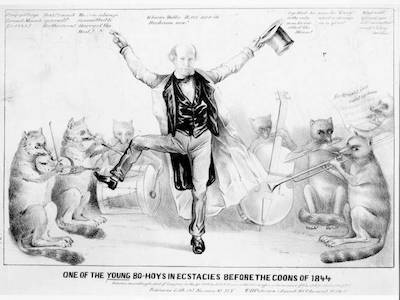Return of the Whigs
A New Path after the Fall
October 1, 2016
I hesitate to bog down my narrative with actual history, but an
absence of any grounding in actual history has become manifest
throughout the process (ordeal) of this election season. Lincoln was
the first Republican president and served one term as a Whig
congressman. The Whig
party was the primary contender to Andrew Jackson’s Democratic
party until 1856. The Whig split created regional factions; the
contingent from the Northern states became Republicans. The
Republicans became a major party because as John
Prine would say “… voted for Eisenhower because Lincoln won the
war.” Irreconcilable differences over slavery ended the Whigs, then
divided the Democrats and the Union.
Many of our modern pundits would claim old history lessons about
politics have no connection to today’s politics; we are in a different
age. The two main parties are institutionalized (ask
David Gill, inside Illinois joke) there could not be a split as
in the 1850’s. Most journa-perts might think we have a two party
system almost as structural as if these entities were established in
an article of the constitution. I think we are about to enter a new
era; the Republican Party will split. If a faction of the Whig party
could morph into the Republicans party, then why not a return of the
Whigs? I can assure you one of the new factions can easily claim the
Know-nothing label.
Whig Victory New York 1844 Racoons a Henry Clay Whig mascot
I made this suggestion of the coming Republican split back in March when I wrote Take Them in Detail. Winning elections unites a political party. This election is the beginning of the GOP becoming the Chicago Cubs of winning presidential elections. The party may have good seasons, but it will be many years before it wins the World Series. The Democratic Party lost its dominance as the Roosevelt coalition fell apart. Why did that occur? It was because the factions within the coalition had mutually hostile agendas. FDR united vast majorities when our nation was in a great economic crisis and then through a war that required a solid front and unified action. A Southern Democratic Party could not co-exist with a FDR party enforcing constitutional rights to vote. Their supremacy had been established by a reign of terror using beatings, burnings, and lynchings. The economic benefits the New Deal brought to everyone could not mitigate against old power struggles that returned once the Depression and World War Two were behind us. Florence Reece’s old union song “Which Side are You On?” represented choices the political parties faced beyond worker’s rights or owner’s power. The Democratic Party had to decide which side it was on; the segrationists left when civil rights won. The fifties began the great realignment of our two parties.
Pete Seeger with Swedish Subtitles
After WWII the Republican Party retained its mantle as the party of business and the party of emancipation. The nearly one hundred year old party of emancipation could not retain the social justice agenda. African-Americans were no longer slaves, but the business class didn’t want people of color in their country clubs. They didn’t accept Jewish people and were just beginning to overcome their aversion to Catholic Americans. The Democratic Party became the party of civil rights and the great exodus began. Southern Democrats and Corporate Republicans saw mutual interests and affinities. The Redneck States became Republican Red. ...




